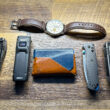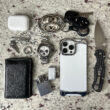If you’re just getting into everyday carry, one of the best places to start is with something you probably already own: your wallet. Chances are you’ve got something bigger and bulkier than it needs to be. I recommend upgrading to a proper EDC wallet—one that’s as slim, minimal, and efficient as possible.
Why Carry a Minimalist Wallet?
Right off the bat, there’s a number of problems with carrying a big, traditional wallet. Because they’re so big, you’re probably keeping it in your rear pocket, where it’s more likely to fall out. Even if you’re lucky enough to avoid that nightmare, by sitting on your wallet, you’re risking a needless potential spine injury. It’s best to carry your wallet in your front pocket if you can, for your spine and security’s sake.
I know some of you just hate the feeling of too much stuff in your pockets (although if you’re on this site, maybe your definition of too much stuff is different than others). This is where minimalist wallets come in. By design, they fit better in your pocket and can even be a little restrictive at times, encouraging you to be more considered in what you actually keep in them. Traditional wallets with a ton of card slots make it so easy to overstuff them with cards you’ll probably never use while you’re out.
Money and Material Things

In the everyday carry scene, you hear the phrase “form follows function” thrown around a lot. But one part of the equation doesn’t get the attention it deserves, especially when it comes to wallets: materials.
If you think about wallets as much as I do (and I hope you don’t, because that would be kinda sad), you’d realize the material of choice becomes a huge factor in shaping the design of the wallet.
Traditionally, most wallets are made of leather. The growing popularity of minimalist EDC wallets gave rise to non-leather options like elastic wallets and even metal ones. Of course, other types of wallets exist: duct tape, Tyvek (like those crazy durable envelopes), sailcloth, and firehose, just to name a few.
Leather, elastic, and metal are the big three wallet materials I’m going to look at today and want to hear your opinion about. Ultimately, this will all help you narrow your search for the perfect wallet to slip into your front pocket.
Leather EDC Wallets
Leather is comfortable, durable (but not water resistant), and looks better with age. Depending on the kind of leather, they can be super supple or more rigid and beefy. Regardless, quality leather has a luxurious, organic feel in hand that’s hard to replicate. Aesthetically, leather wallets are versatile enough to fit in modern or classically styled EDCs alike.
Wallets made from leather tend to be thicker, especially if they layer pieces of leather to create individual card slots, as all that material adds up. Leather does stretch a tiny bit, but not much. As a result, your wallet takes up a fixed amount of space in your pocket. If you carry only a few cards, you might end up with “wasted” or unused space in your wallet. If you carry lots, you might (irreversibly) stretch your wallet out or find storing and retrieving tight-fitting cards to be a hassle.
Pros:
- Comfortable in the hand and in the pocket
- Looks better with age
- Durable enough for most people
Cons:
- Can get bulky or lead to overcarrying
- Generally not weather resistant
- Often costs more depending on quality of leather
Examples of leather EDC wallets: Bellroy Slim Sleeve, Anson Calder 1/8” Calfskin Wallet, Nodus Compact Wallet
Elastic EDC Wallets

If your top priority is having the slimmest, most compact wallet possible, look into elastic wallets. Functionally, an elastic wallet is like a glorified rubber band. While they’re not for everyone, they’re the best at taking up as little space in your pocket as possible, no matter how many cards you carry. The tension from the elastic band keeps a snug fit on as little as one card, but easily expands to secure a much larger set of cards (as shown above).
Usually, elastic wallets don’t offer much organization for individual cards in the interest of achieving the slimmest possible profile. You might see one or two quick access slots for your most used cards, but the rest of your cards are usually stacked on top of each other. This shouldn’t be too much of a problem as these minimalist wallets encourage carrying fewer cards anyway.
Carrying cash in an elastic wallet isn’t as convenient as other options either. You’d usually have to fold bills a few times for it to fit in a wallet so small, and all that folding adds more thickness. Paper bills also lack the rigidity cards have, so the tension in the elastic can crumple them up.
Pros:
- Achieves maximum slimness
- Slim by default due to tension, but can expand to accommodate more cards
- Usually less expensive
Cons:
- Less durable as a material
- Less organization overall
- Tension may be too loose (not secure), or too tight (difficult to use)
Examples of elastic EDC wallets: Elephant E8 Wallet, Trove Wallet, Infinity Wallet, BASICS Wallet
Metal EDC Wallets

Metal adds structure and rigidity to a wallet without all the bulk. Like other tools in your everyday carry, a metal wallet will be sturdy and potentially overkill if you just need something to keep your cards in one place (better safe than sorry, right?).
In these wallets, the metal component is usually either a single unibody frame or a set of plates that sandwich your cards. Typically, they use an elastic band or O-rings to secure the cards, so some of the pros and cons of elastic wallets explained above apply here to a lesser extent.
Smooth metal surfaces and typically compact designs make metal wallets easy to slip in and out of your pocket, but they aren’t the most pocket friendly overall. They can wear out your pockets faster, scratch other gear you’re carrying, and feel heavier than leather, elastic, or other fabric options. Despite all this, they’re still common with EDCers for hitting the mark on ruggedness and efficiency.
Pros:
- Most overall durability, with high impact and weather resistance.
- Improved security with RFID protection
- Good balance of slimness and durability
Cons:
- Less comfortable in the pocket and can wear down fabric
- Can scratch other gear in your pockets
- May add extra weight (stick to aluminum or titanium if possible)
Examples of metal EDC wallets: Trayvax Element, RIDGE Wallet, Machine Era Slim Wallet
Which of these three materials is best for most people?
As far as materials go, leather probably wins here. Any shortcomings from leather as a material can be fixed by the wallet’s design or how you carry your cards. They manage a good balance of comfort, durability, and pocket friendliness.
If you’re a diehard minimalist who prefers only keeping a few cards on them, you’d probably vibe with an elastic wallet.
If you’re after something sleek and ultra-rugged and you don’t mind dealing with a little discomfort for the sake of cool, well-engineered gear, look into metal.
So, what’s your preferred wallet material for everyday carry? Leave a comment below as I’d love to hear other EDCers’ take on this.
There’s a good chance your go-to wallet isn’t made from any of these materials too. While other wallet materials don’t impact the design and usability of wallets as much as these do, we’ll still take a closer look at those options in future articles. In the meantime, you can find even more wallet options in these buying guides:
Wallets pictured in header, clockwise from top left: Bellroy x Barneys NY Slim Sleeve, OBSTRUCTURES A4, Secrid Wallet, Trayvax Element, minimum squared m^2, Trove Wallet, Capsule Minimalist










